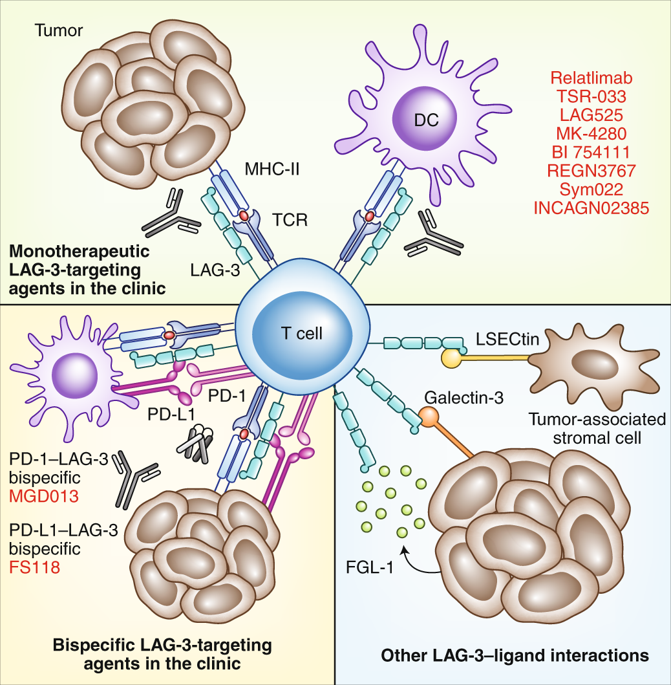当前位置:
X-MOL 学术
›
Nat. Immunol.
›
论文详情
Our official English website, www.x-mol.net, welcomes your
feedback! (Note: you will need to create a separate account there.)
Inhibitory receptors and ligands beyond PD-1, PD-L1 and CTLA-4: breakthroughs or backups.
Nature Immunology ( IF 27.7 ) Pub Date : 2019-10-14 , DOI: 10.1038/s41590-019-0512-0 Lawrence P Andrews 1 , Hiroshi Yano 1, 2 , Dario A A Vignali 1, 3
Nature Immunology ( IF 27.7 ) Pub Date : 2019-10-14 , DOI: 10.1038/s41590-019-0512-0 Lawrence P Andrews 1 , Hiroshi Yano 1, 2 , Dario A A Vignali 1, 3
Affiliation

|
Although immunotherapeutics targeting the inhibitory receptors (IRs) CTLA-4, PD-1 or PD-L1 have made substantial clinical progress in cancer, a considerable proportion of patients remain unresponsive to treatment. Targeting novel IR-ligand pathways in combination with current immunotherapies may improve clinical outcomes. New clinical immunotherapeutics target T cell-expressed IRs (LAG-3, TIM-3 and TIGIT) as well as inhibitory ligands in the B7 family (B7-H3, B7-H4 and B7-H5), although many of these targets have complex biologies and unclear mechanisms of action. With only modest clinical success in targeting these IRs, current immunotherapeutic design may not be optimal. This Review covers the biology of targeting novel IR-ligand pathways and the current clinical status of their immunotherapeutics, either as monotherapy or in combination with antibody to PD-1 or to its ligand PD-L1. Further understanding of the basic biology of these targets is imperative to the development of effective cancer immunotherapies.
中文翻译:

PD-1、PD-L1 和 CTLA-4 以外的抑制性受体和配体:突破或备用。
尽管针对抑制性受体 (IR) CTLA-4、PD-1 或 PD-L1 的免疫疗法在癌症治疗中取得了实质性的临床进展,但仍有相当一部分患者对治疗无反应。针对新的 IR 配体途径与当前的免疫疗法相结合可能会改善临床结果。新的临床免疫疗法靶向 T 细胞表达的 IR(LAG-3、TIM-3 和 TIGIT)以及 B7 家族中的抑制性配体(B7-H3、B7-H4 和 B7-H5),尽管其中许多靶点具有复杂的生物学和不清楚的作用机制。由于针对这些 IR 的临床成功率有限,目前的免疫治疗设计可能不是最佳的。这篇综述涵盖了靶向新型 IR 配体通路的生物学及其免疫疗法的当前临床状态,作为单一疗法或与针对 PD-1 或其配体 PD-L1 的抗体联合使用。进一步了解这些靶标的基本生物学对于开发有效的癌症免疫疗法至关重要。
更新日期:2019-10-14
中文翻译:

PD-1、PD-L1 和 CTLA-4 以外的抑制性受体和配体:突破或备用。
尽管针对抑制性受体 (IR) CTLA-4、PD-1 或 PD-L1 的免疫疗法在癌症治疗中取得了实质性的临床进展,但仍有相当一部分患者对治疗无反应。针对新的 IR 配体途径与当前的免疫疗法相结合可能会改善临床结果。新的临床免疫疗法靶向 T 细胞表达的 IR(LAG-3、TIM-3 和 TIGIT)以及 B7 家族中的抑制性配体(B7-H3、B7-H4 和 B7-H5),尽管其中许多靶点具有复杂的生物学和不清楚的作用机制。由于针对这些 IR 的临床成功率有限,目前的免疫治疗设计可能不是最佳的。这篇综述涵盖了靶向新型 IR 配体通路的生物学及其免疫疗法的当前临床状态,作为单一疗法或与针对 PD-1 或其配体 PD-L1 的抗体联合使用。进一步了解这些靶标的基本生物学对于开发有效的癌症免疫疗法至关重要。






























 京公网安备 11010802027423号
京公网安备 11010802027423号